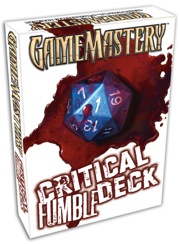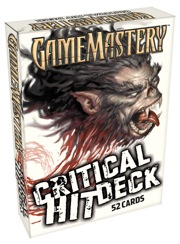
When playing 3.5 DnD, or even the new Pathfinder, sometimes a critical hit just doesn't feel that...well, critical. Doing x2 damage is all well and good, but sometimes you want to eviscerate your foe, causing him to bleed to death, or smack him so silly he's seeing stars for a few rounds. By the same token, missing on a 1, while annoying, just isn't very descriptive. So you critical fumbled, how did you do it?
Well, thanks to Paizo's Critical Hit and Critical Fumble Decks you get a little more out of your Critical die rolls. The premise of both cards is that when you roll a 1 (for the Critical Fumble Deck), or confirm a critical threat (for the Critical Hit deck) you draw a card from the deck, compare it to what kind of attack you made (magical, natural, slashing, ranged) and that card tells you what action your critical took. Things from an extra attack roll all the way to decapitation (for the Critical Deck) or dropping your weapon to hitting yourself with your own spell (for the Critical Fumble Deck).
The Good
Besides helping busy DMs with go-to descriptions for Critical hits and fumbles, the cards keep the game lively. I use them myself and my players are always excited about a critical hit, calling for a draw from the deck almost before the threat has been confirmed. By the same token, it helps lessen the effect of a critical fumble. Sure, you are making a failure more than just an automatic miss, but from my experience the players don't mind rolling a 1 quite so much now that it comes with an interesting explanation.
The Evil
This system isn't entirely balanced. One of the critical hit cards, as mentioned above is
 decapitation. That is a pretty powerful thing, even when its as rare as a 1 in 52 chance already tacked on to less than 5%. A critical already has the chance to obliterate a well crafted plan by destroying NPCs and villains who were meant to live longer, adding in an additional chance for them to perish increases this problem. The other issue is that the two decks are meant to work together. You don't have to of course, you could easily use the critical hit deck or fumble decks by themselves. Keep in mind though, that in 3.5 D&D, not every monster is capable of receiving a critical hit, if you run a campaign where the players fight a lot of undead, constructs or other creatures immune to critical hits the fumble deck becomes a much more serious issue as it isn't balanced by the benefits of the critical deck.
decapitation. That is a pretty powerful thing, even when its as rare as a 1 in 52 chance already tacked on to less than 5%. A critical already has the chance to obliterate a well crafted plan by destroying NPCs and villains who were meant to live longer, adding in an additional chance for them to perish increases this problem. The other issue is that the two decks are meant to work together. You don't have to of course, you could easily use the critical hit deck or fumble decks by themselves. Keep in mind though, that in 3.5 D&D, not every monster is capable of receiving a critical hit, if you run a campaign where the players fight a lot of undead, constructs or other creatures immune to critical hits the fumble deck becomes a much more serious issue as it isn't balanced by the benefits of the critical deck.Bang For Your Buck
Each deck costs $9.99, and for that you receive 52 cards with 4 different outcomes on each one, each outcome pertaining to a different type of attack. You also receive rules with advice for how to balance the cards for use in your campaign, and some new mechanics for your game that enhance the rules presented.
The Final Verdict
I endorse these products wholeheartedly, I've been using them in my games for around a year now and they definitely keep things both interesting and fun. They are cheap, they are are well made, and they make combat a little more complex. If that's not what you want, I can see you not getting them, but if you want to make your fights a place where a man can lose some fingers, or a fighter's sword could go flying out of his grasp during a dangerous maneuver, these cards will help you make it happen.
Francis Bousho is a participant in the Amazon Services LLC Associates Program, an affiliate advertising program designed to provide a means for sites to earn advertising fees by advertising and linking to amazon.com.


2 comments:
I have the fumble deck and used it for a few sessions. I ended up abandoning it, for a chart of my own creation, however, as I wasn't entirely happy with the idea of players striking themselves and comrades lol
Yeah, people hitting themselves definitely changes the nature of the game. I'll admit, there have been times when the Players have drawn cards that I've said "Decapitation, do you guys really want the fight to end?" or "Wow, that disintegrate spell hits you...how's everybody feel about drawing a different card?"
But I'd love to know more about this chart, do you care to share it?
Post a Comment